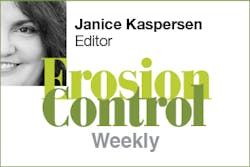Agricultural Conservation: Finding Out What Works

A survey now underway by the USDA hopes to characterize what’s working and what isn’t in terms of conserving soil, protecting water quality, and preserving habitat on agricultural lands.
USDA’s National Agricultural Statistics Service (NASS) is in the first phase of a multi-year project to gather data on what sorts of conservation practices farmers have in place and what they still need. Over the next month or so, NASS will contact about 24,000 farmers and ranchers across the country, asking questions about their land and operations to determine whether they are eligible to participate. Later this year and in early 2016, eligible respondents will be invited to take the survey, and the whole process will be repeated again later in 2016 with a different set of ag producers to get more responses.
A survey now underway by the USDA hopes to characterize what’s working and what isn’t in terms of conserving soil, protecting water quality, and preserving habitat on agricultural lands. USDA’s National Agricultural Statistics Service (NASS) is in the first phase of a multi-year project to gather data on what sorts of conservation practices farmers have in place and what they still need. Over the next month or so, NASS will contact about 24,000 farmers and ranchers across the country, asking questions about their land and operations to determine whether they are eligible to participate. Later this year and in early 2016, eligible respondents will be invited to take the survey, and the whole process will be repeated again later in 2016 with a different set of ag producers to get more responses. [text_ad] Officially called the Conservation Effects Assessment Project, or CEAP, the survey seeks to measure environmental benefits of conservation practices on both cultivated and non-cultivated agricultural lands. The data will show which practices are most effective and which are not working as well, and will provide guidance for improving technical and financial assistance to help farmers and ranchers install good conservation measures in the future. To gain participation, NASS ensures that all responses are private and that no individual participant or farm can be identified. NASS says that, by law, “the responses cannot be used for the purposes of taxation, investigation, or regulation.” NASS conducts the survey under a cooperative agreement with the Natural Resources Conservation Service. NRCS has initiated various voluntary conservation programs for ag producers, including the Cooperative Conservation Partnership Initiative (now replaced by the Regional Conservation Partnership Program) and the Conservation of Private Grazing Land Program.Officially called the Conservation Effects Assessment Project, or CEAP, the survey seeks to measure environmental benefits of conservation practices on both cultivated and non-cultivated agricultural lands. The data will show which practices are most effective and which are not working as well, and will provide guidance for improving technical and financial assistance to help farmers and ranchers install good conservation measures in the future.
To gain participation, NASS ensures that all responses are private and that no individual participant or farm can be identified. NASS says that, by law, “the responses cannot be used for the purposes of taxation, investigation, or regulation.”
NASS conducts the survey under a cooperative agreement with the Natural Resources Conservation Service. NRCS has initiated various voluntary conservation programs for ag producers, including the Cooperative Conservation Partnership Initiative (now replaced by the Regional Conservation Partnership Program) and the Conservation of Private Grazing Land Program.About the Author
Janice Kaspersen
Janice Kaspersen is the former editor of Erosion Control and Stormwater magazines.


